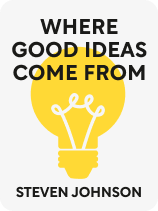

This article is an excerpt from the Shortform book guide to "Where Good Ideas Come From" by Steven Johnson. Shortform has the world's best summaries and analyses of books you should be reading.
Like this article? Sign up for a free trial here.
Have you ever had a sudden burst of inspiration that led you to a new solution to a problem? Do you ever marvel at seemingly impossible modern inventions like the internet?
If so, you might wonder how individuals come up with such incredible innovations and how they develop them over time. In Where Good Ideas Come From, Steven Johnson explains that good ideas and novel innovations are largely the result of social collaboration.
Continue reading for an overview of this fascinating book.
Overview of Where Good Ideas Come From by Steven Johnson
In Where Good Ideas Come From, Steven Johnson explains that, for an idea to be good, it must be built upon accumulated knowledge and be put forward at a time when users can conceive of how to use the idea and when the needed resources for the idea are available. Ideas can result from a combination of underlying unfinished ideas fed over time, sudden inspiration, mistakes, and the practice of using other innovations for purposes distinct from their original functions.
Steven Johnson is a best-selling author and theorist who frequently contributes to outlets like The New York Times and The Wall Street Journal. His other works include Everything Bad is Good for You, Future Perfect, and Enemy of All Mankind.
We’ll examine how good ideas build on previous ones and combine via networking. We’ll also explore how good ideas can be cultivated over time, how they can suddenly be realized through insights, how mistakes lead to new ways of thinking, and how changing the way we use a previous idea or innovation can create a new innovation. Finally, we’ll look at how capitalism affects the development of ideas and innovations.
How Ideas Develop
According to Johnson, good ideas don’t emerge miraculously from nothing. Instead, they build on existing knowledge and ideas. If every writer had to create their own writing system, or if every app developer had to reinvent the internet, we wouldn’t be able to progress as a society and would be stuck with only the most basic ideas. The more we innovate and create, the more we draw on established knowledge to innovate further, enabling us to come up with increasingly advanced ideas.
These previous ideas provide platforms of knowledge on which to build. Platforms can be physical—such as a piece of technology like a steam engine or a computer—or conceptual—such as the ideas and knowledge that allowed us to create such technologies. Platforms not only prop up new ideas, but they also provide parameters, or, in the case of the arts, genres. It’s necessary to understand these parameters in order to bend or break them, which allows for greater insight and innovation.
Combining or shifting across platforms of knowledge can open up further opportunities for discovery. Johnson gives the example of how scientists figured out Darwin’s Paradox. This combination of sciences led to a new field called ecosystems ecology.
Johnson points out two other hallmarks of the most successful ideas. We’ll look at both hallmarks next.
Developing Ideas That Are Within Reach
Platforms of knowledge also shape the realm of the adjacent possible. The adjacent possible is a theory developed by Stuart Kauffman that refers to the realm of new ideas that are within reach based on society’s current available information, resources, and abilities. While good ideas can come from outside the adjacent possible, all successfully implemented ideas come from within it.
Ideas developed in the adjacent possible are understandable and achievable at the time they’re created. Those that are developed outside the adjacent possible may be great ideas, but a lack of knowledge or resources makes them unachievable at the time they’re created. Such ideas fail but may be developed later when the needed resources become available.
To explain the adjacent possible, Johnson discusses the work of the inventor Charles Babbage. In the 1830s, Babbage developed the idea for what would have been the first-ever programmable computer. Because of the resources and knowledge available to him, the computer would have been made entirely of mechanical parts and would have been incredibly slow if he had managed to build it. The idea failed because it was outside the realm of the adjacent possible, but a century later, our cumulative knowledge and resources had widened the adjacent possible to encompass this invention, and modern computers were then developed using the same basic blueprints that Babbage had created.
The idea of the adjacent possible helps explain the phenomenon of “the multiple.” This is a historical trend in which the same novel idea is discovered by multiple people working independently of each other. If different people are working from the same knowledge base, then the realm of possibilities for their work will be similar, even if they aren’t working together, because they’re all limited to the base knowledge’s adjacent possible.
Networking to Create Better Ideas
According to Johnson, having networks of ideas that build and connect with each other is also essential to come up with good ideas. Networks can take many different forms, including physical communities, online spaces, or anything that facilitates collaboration between people. They can even include the networks that comprise our own brains. Johnson suggests that, the more people who are involved in a network, the more effective they’ll be at spawning and promoting ideas.
One of the most important networks Johnson discusses is the city. He points out that, in the age of the hunter-gatherer, we remained in small groups that rarely met or collaborated with each other. In these environments, even if some lone individual had a great idea, it was rarely shared widely or improved upon by others since people had no means of record-keeping. After the development of agriculture, we began to gather in large groups, forming communities that grew into cities. These cities led to a great confluence of different thoughts and perspectives, and importantly, the storing and recording of ideas through common knowledge or written language.
In recent years, the internet has proven to be an effective tool for networking ideas, as well. The internet provides immediate access to vast amounts of information and, unlike city networking, it can be accessed no matter where you are geographically.
We rely on networks between people, but we also rely on networks within our brains. The brain consists of a hundred billion neurons with 100 trillion connections between them. Like a network of people, the power of these neural networks comes from the connections rather than the individual neurons. These connections and their ability to change and form new patterns—an ability known as plasticity—are the key to the mind’s ability to learn and grow.
Now that you understand how ideas form, you can apply that understanding to better harness the upcoming forms of ideation. We’ll now look at some of the processes that go into the formation of good ideas, including the development of unfinished ideas over long periods of time, sudden insights, mistakes, and exaptation.
Developing Ideas Over Time
Most ideas take a long time to develop and require a lot of patience. They begin as suspicions, hunches, or ideas that aren’t yet complete, and often, they need to be combined with other people’s unfinished ideas to take shape—which is part of why networks are so important. Ideas like this can brew for years or decades before they find the other ideas that complete them and push them into the realm of the adjacent possible.
Johnson distinguishes these unfinished ideas from gut instincts. While both can act as underlying ideas that lead to something greater, gut instincts are immediate and fast. Unfinished ideas or hunches begin with an inexpressible suspicion that there is something greater at play in a situation or problem you’re considering, and they don’t lend themselves to quick decisions like gut instincts do. Instead, they remain in the back of your mind for long periods of time, slowly connecting to new things you’re learning and eventually coalescing into a whole idea that’s greater than the sum of its parts.
It’s easy to lose track of these long-term partial ideas. They can be nebulous and ill-defined, which makes them easy to forget. To keep track of these ideas, Johnson recommends that you record each one that you have.
Making Workplaces Conducive to Idea Formation
Johnson also notes that people who bring ideas like this to fruition are often able to develop them as part of their careers.
To encourage this type of innovation, companies like Google deliberately set aside certain percentages of their employees’ work time (20%, specifically) for them to pursue ideas that interest them outside of their specific roles at the company. While most of the ideas developed during this time are never used by the companies, they often lead to highly profitable innovations. In Google’s case, their tools AdSense and Gmail both came from ideas developed during this designated time. And, the company’s vice president of Search Products and User Experience has said that ideas created during this designated time account for more than half of the company’s new products.
Creating Ideas From Sudden Insights
Sometimes ideas can click suddenly into place as a result of inspiration or insight, writes Johnson. Rather than coming together purely from steady, incremental development, an idea that you’re mulling over can be spontaneously completed by an epiphany.
Johnson explains how the brain goes through periods of neural synchronization—called neural phase locking—that alternate with periods of chaos. During neural phase lock, the brain’s neural networks are firing simultaneously at the same frequency. In contrast, there are other periods where all the neurons are firing completely out of sync with each other. During these periods of chaos, scientists believe the brain is making links and associations that it wouldn’t normally make, resulting in new ideas and connections. Research into neural phase locking in children showed that individuals varied in the amount of time their brains spent in each phase and that longer periods in the chaotic phase correlated with higher IQs.
The brain also makes new links and connections when dreaming or daydreaming. Dream states are also states of neural chaos, where the brain triggers memories and thoughts at random that cause us to dream—and sometimes result in moments of brilliance.
Collaborating With Technology
Additionally, Johnson suggests that technology can help us make sudden insights. He describes an indexing software that he uses called DEVONthink that helps him catalog information and search for it with an algorithm that detects not only verbatim search terms but also terms related to what he’s searching (like returning results including the word “waste” when he searches for the word “sewage”). He describes how this tool has given him insights that he doesn’t think he could have achieved otherwise and suggests that these insights weren’t solely his own but were instead the result of collaboration between two intelligences: his own, and the software’s artificial intelligence.
Google can provide a similar collaborative search function to DEVONthink but with the added benefit of being able to draw from the entirety of the internet’s information. Johnson points to criticism of internet search engines by writers who suggest that it has ended the practice of going to the library, browsing the shelves, and pulling out books that interest you at a glance. However, Johnson points out that this wasn’t a practice that everyone—or even most people—made a habit of. While their searches are now curated by internet filters—which he says are actually beneficial since they block out all the irrelevant search results—more people are searching the internet than ever browsed libraries in the way these critics lament.
Cultivating Sudden Insights
To put yourself in a state that promotes sudden insights, Johnson recommends taking a walk or a bath. These activities take your mind off of your daily tasks and put you in a more associative state, letting your unconscious mind make those important connections.
Another way to open yourself up to sudden insights is to take in as much new information as you can through reading or other means. Johnson notes that a flaw in this process is that it’s easy to forget what you’ve learned from these sources if you’re only taking in a little bit of information each day. He points out that people like Bill Gates take annual reading vacations, where they take a week or more to deep dive into books they’ve added to their reading list, allowing them to absorb and process all the new information in a concentrated period of time. Johnson suggests that it may benefit workplaces to allot time for such vacations since they can be so beneficial in creating new ideas.
Forming Ideas by Making Mistakes
Johnson argues that mistakes can lead to better ideas and greater innovations. Many inventions throughout history have been the result of mistakes, including penicillin, the daguerreotype, and the pacemaker. He suggests that making mistakes and then exploring why those mistakes happened makes people smarter. Mistakes open us up to new ways of thinking and prompt us to explore additional ideas in the adjacent possible.
Johnson also describes a study carried out by Berkeley professor Charlan Nemeth that showed that mistakes in group settings (or networks) cause people to think more flexibly. In the study, a group of participants was shown a series of colors on different slides and asked to list some words they associate with those colors. The vast majority of the associations were predictable, like associating green with “grass.” However, in subsequent studies, actors were added to the group who deliberately identified the colors incorrectly, like saying they saw a blue slide as green. The actual participants then began making much more creative associations, suggesting that adding inaccurate information to the group’s pool of knowledge led to greater creativity. Further studies showed similar results in settings like mock juries.
Johnson notes that even evolution makes use of errors to improve a species. Mutations, which are essentially errors in DNA, create changes in an organism, and if those changes are beneficial to its survival, they’re passed down to its offspring. The majority of mutations are either neutral or harmful, but some push a species into a new realm of the adjacent possible, which is how we went from single-cell organisms billions of years ago to the vast array of diverse species we have today.
Johnson suggests that organizations that seek to eliminate error are closing themselves off to greater ideas in the adjacent possible. He says that, while the goal shouldn’t be to make mistakes, they should be embraced and allowed to happen. Only then can we truly understand and learn from them.
Innovating Ideas Through Exaptations
Johnson also describes how exaptations—using a tool or trait in a context that’s different from the one it was originally intended for—can lead to innovation. Exaptation is a term from evolutionary biology for when a trait that evolved for one purpose changes function and is used for another purpose.
Exaptation plays a large role in media and art. Taking a narrative device like stream-of-consciousness writing and adapting it for film changes its function and creates a new innovation in cinematic storytelling.
Johnson explains that networks such as cities are hotbeds of exaptation because they help connect people with different ideas and cultures. When these differences collide, they lead to greater innovation and more creative ideas.
Capitalism’s Effect on Ideas and Innovation
According to Johnson, good ideas come largely from social interaction and the sharing of knowledge through networks. He points out that, especially in the modern world, there are limits to information sharing, particularly when there is a financial incentive to keep information secret through things like copyright, patents, and intellectual property laws. The competitive nature of capitalism encourages companies to keep their innovations under wraps so that other companies can’t take those same innovations and use them for their own benefit. Johnson suggests that this tendency may limit our innovative ability as a society.
Johnson looks at innovations throughout history and categorizes them based on whether they were market-driven or non-market-driven, and also whether they were created by an individual or by a network of people. Based on his assessment of hundreds of major inventions and innovations throughout history, he sees a shift over time: during the Renaissance, most innovations were non-market-driven and developed by an individual. This trend gradually shifted and today, most ideas are still non-market-driven but are developed by networks. He suggests that this contradicts the capitalist principle that competition and profit motive are the primary drivers of innovation.
He doesn’t use these conclusions to call for a different economic system but instead suggests that we should shift our society toward a more open system of sharing ideas and information, one similar to the way universities and research institutions work—as opposed to corporate R&D labs.

———End of Preview———
Like what you just read? Read the rest of the world's best book summary and analysis of Steven Johnson's "Where Good Ideas Come From" at Shortform.
Here's what you'll find in our full Where Good Ideas Come From summary:
- How the world's best inventions grow from minor inklings
- How capitalism negatively impacts innovation
- Why making mistakes is essential to great innovations






